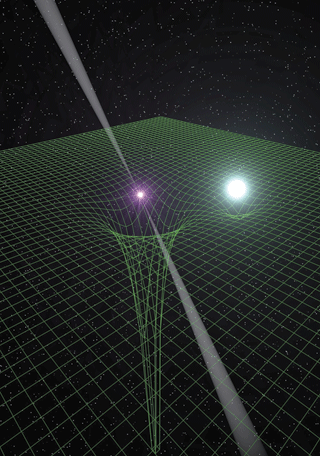This article is more than 1 year old
CURSE you, EINSTEIN! Humanity still chained in relativistic PRISON
'Collapsar jump' from Forever War seemingly not on cards
Disappointing news on the science wires today, as new research indicates that a possible means of subverting the laws of physics to allow interstellar travel apparently doesn't work.

Curses! Can nothing pierce this damned rubber sheet?
As we are told in a new paper just published in hefty boffinry mag Science:
Neutron stars with masses above 1.8 solar masses possess extreme gravitational fields, which may give rise to phenomena outside general relativity.
That would be quite handy, as one of the rules of general relativity is that nothing can travel faster than light: which means that journeys between the stars must take years or centuries at minimum, and that humanity is probably imprisoned in the immediate vicinity of our home Sun - a tiny pinprick of space on the vast canvas of the universe.
But with the aid of a handy neutron star - aka collapsar, as such bodies consist of collapsed matter in which all the atoms have been crushed down into an unfeasibly incrediblo-dense blob of neutrons - one might perhaps violate Einsteinian physics and so somehow permit human beings to travel the wider universe. Science fiction writer Joe Haldeman speculated to this effect in his classic work The Forever War, in which starships would leap across the galaxy by means of the "collapsar jump":
They had discovered the collapsar jump. Just fling an object at a collapsar with sufficient speed, and it pops out in some other part of the galaxy. It didn't take long to figure out the formula that predicted where it would come out: it travels along the same "line" (actually an Einstein geodesic) it would have followed if the collapsar hadn't been in the way - until it reaches another collapsar field, whereupon it reappears, repelled with the same speed at which it approached the original collapsar. Travel time between the two collapsars ... exactly zero.
But our crew of physicists writing in Science are having simply none of this. They've found a powerful collapsar named PSR J0348+0432, and cunningly managed to measure the effects of its outrageously powerful space-warping gravitational field by monitoring the behaviour of an orbiting "lightweight dwarf" star.
Disappointingly, it seems that even this brutal mangling of the space-time continuum is not enough to suspend Einsteinian physics. The scientists write:
For these masses and orbital period, general relativity predicts a significant orbital decay, which matches the observed value ...
The consistency of the observed orbital decay with general relativity therefore supports its validity, even for such extreme gravity-matter couplings, and rules out strong-field phenomena predicted by physically well-motivated alternatives.
So much for the collapsar jump, then.
"The observations disprove these alternatives and thus give further confidence that Einstein's theory is a good description of nature," says spoilsport astronomer Marten van Kerkwijk of Toronto uni, one of the investigating boffins.
However he leaves us a tiny bit of hope, adding:
" – even though we know it is not a complete one, given the unresolved inconsistencies with quantum mechanics."
The new paper can be read by subscribers here. ®
